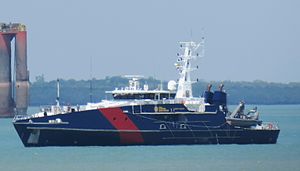 ACV Cape St George on Darwin Harbour in 2014
| |
| Class overview | |
|---|---|
| Name | Cape class |
| Builders | Austal |
| Operators | |
| Preceded by |
|
| Cost | AU$54 million (US$40.6 million) per unit (FY 2020) |
| Built |
|
| In service | 2013–present |
| Planned | 24 |
| Completed | 18 |
| Active | 18 |
| General characteristics | |
| Type | Patrol boat |
| Displacement | 400 Tonnes |
| Length | 57.8 m (189 ft 8 in) |
| Beam | 10.3 m (33 ft 10 in) |
| Draught | 3 m (9 ft 10 in) |
| Propulsion |
|
| Speed | 25 knots (46 km/h; 29 mph) |
| Range | 4,000 nmi (7,400 km; 4,600 mi) at 12 knots (22 km/h; 14 mph) |
| Endurance | 28 days |
| Boats & landing craft carried |
|
| Crew | 18 |
| Sensors and processing systems |
|
| Armament | 2 deck-mounted 0.50 calibre machine guns[2] |
The Cape class is a ship class of 22 large patrol boats operated by the Marine Unit of the Australian Border Force, the Royal Australian Navy (RAN) and the Trinidad and Tobago Coast Guard. Ordered in 2011, the vessels were built by Austal to replace Customs' Bay-class patrol boats, and entered service from 2013 onwards. Following availability issues with the Armidale class, two vessels were chartered by the RAN from mid-2015 to late 2016. A further two vessels were ordered at the end of 2015 by the National Australia Bank, who will charter the patrol boats to the Department of Defence from completion in 2017. 2 vessels were ordered by Trinidad and Tobago for their coast guard in 2018 with the vessels delivered in 2021. The RAN placed an order for six 'Evolved' Cape-class vessels in 2020, a second order in 2022 for an additional two vessels, a third order in 2023 for a further two vessels, and a fourth order in 2024 for a further two vessels, for the Australian Border Force (ABF). [3]
On 12 December 2024, four of the Cape class vessels were commissioned into the Royal Australian Navy.[4]
- ^ a b "Cape Class Patrol Boats, Australia". Naval Technology. Verdict Media Limited. Retrieved 12 July 2018.
- ^ "Immigration and Border Protection Portfolio – Legal and Constitutional Affairs Legislation Committee". Parliament of Australia. Senate – Estimates. 19 October 2015. Retrieved 6 December 2016.
- ^ "AUSTAL AWARDED CONTRACT FOR TWO ADDITIONAL EVOLVED CAPE-CLASS PATROL BOATS". 22 December 2024.
- ^ "Royal Australian Navy will commission HMA Ships Cape Pillar, Cape Naturaliste, Cape Woolamai and Cape Capricorn". Facebook. Royal Australian Navy. Retrieved 28 November 2024.
